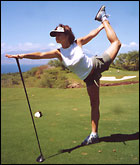All athletes can benefit from the consistent practice of basic yoga postures.

There is often a misconception among athletes the power and benefits of yoga as a conditioning tool. They may have been misled by watching certain types of yoga on TV or by participating in yoga classes where only mild stretching is involved, rather disciplined practice of the classical yoga poses.
How can yoga help athletes?
Learning and practicing yoga can supports training and increase athletic capacity. Due to the nature of some sports, many athletes are subject to damaging movement patterns.
By focusing on the simple movements of basic yoga asanas and building to more complex movements, athletes can learn to correct old, damaging habits and dramatically increase their capacity and endurance.
Everyone who is introduced to yoga starts with some physical imbalances. For example, endurance athletes (eg long-distance runners or bikers) may have ease of movement in one hip or shoulder and restricted movement in the other. With high repetitions of the same movement, the difference is magnified and can cause back or knee problems. Similarly, some sports produce tightness in the front of the hips and shoulders, a condition which may lead to painful back and rotator cuff problems.
Classical yoga movements place emphasis on balance in every direction and require a full range of motion and so they easily reveal imbalances in your body. By building symmetry in your movements, yoga postures allow intensive repetition required by athletic activity and help prevent training injuries.
Sometimes athletes can also fall into a trap when they use momentum and rotation to complete a movement so as to compensate for limitations in their range of motion. In the long run, this technique can be harmful and causes injury or sub-optimal performance.
Yoga practice requires that a student comes face to face with his or her capabilities and learn how to work effectively within those capabilities. It will help you to uncover places in your body where, despite strength, there is either instability (loose joints) or lack of suppleness. Suppleness is not the same as flexibility, but rather, it encompasses strong and fluid movement through the full range of a joint. Yoga develops strength, suppleness, awareness and alignment. It is not just about stretching.
With proper practice, yoga will help you acknowledge your current capacity, accept it and work to improve it. A good introductory yoga class will provide the instruction that is needed for you to practice those basic but important classical poses. While you do so, observe your movement patterns with awareness. This will reveal unhealthy and bad habits so that you can correct them. As an athlete, your objective would be to move in the direction of the poses and not so much to do them perfectly. Even modest and regular practice of basic poses, no matter how perfect or imperfect you do the pose, will enhance your athletic performance.